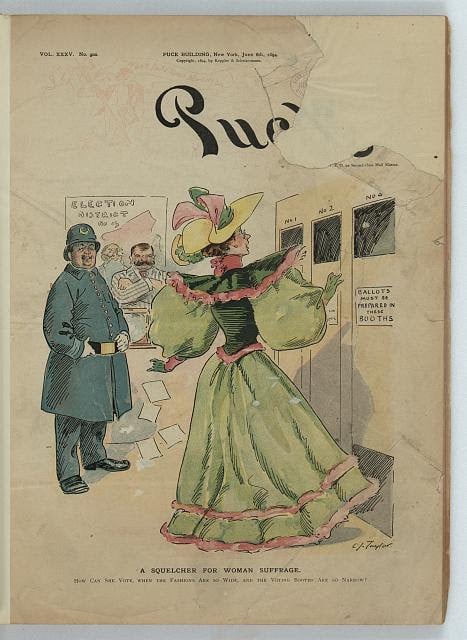
Look closely at the image A Squelcher for Woman Suffrage by C. J. Taylor.
The following activities and questions are designed to help your students use their noticing skills to move through the poem and develop their thinking skills so they understand its meaning with confidence, using what they’ve noticed as evidence for their interpretations. Read more about the framework upon which these activities are based.
-
Warm-up: Look closely at the image A Squelcher for Woman Suffrage by C. J. Taylor. What stands out to you? Why? Read the summary of the image. What stands out from this summary? What questions, if any, do you have?
-
Before Reading the Poem: Listen to this Etta James song “Sufferin’ Till Suffrage.” What words or phrases stand out in the song? Why?
-
Reading the Poem: Silently read the poem “Our Own Twelve Anti-suffragist Reasons” by Alice Duer Miller. What do you notice about the poem? Note any words or phrases that stand out to you or any questions you might have.
-
Listening to the Poem: Enlist two volunteers and listen as the poem is read aloud twice. Write down any additional words and phrases that stand out to you.
-
Small Group Discussion: Share what you noticed about the poem with a small group of students. How do the image and song from the beginning of class connect to the poem? What might the words “our own” from the title mean?
- Whole Class Discussion: How does this poem respond to the suffrage movement? What might the different stanzas say about how people felt at the time about suffrage? Do you notice any statements that contradict? Can you make any connections to current events? Learn more about satire. In what ways is this poem satire?
-
Extension for Grades 7-8: Read more of Alice Duer Miller’s poems. Choose one that you feel speaks to an element in “Our Own Twelve Anti-suffragist Reasons.” How are the poems similar? How are they different? Read your chosen poem aloud and share your ideas with the class.
-
Extension for Grades 9-12: Research more about the women’s suffrage movement. Read more suffrage poems. Create your own research project in which you answer a question that you might have or study a famous figure from the movement. Share your research project with the class.
“The role poetry played in the Nineteenth Amendment’s passing is due in large part to the women’s suffrage publications that sprang up in the late eighteenth and early nineteenth centuries[...] These venues provided forums for women to champion their cause, regularly printing poems that served as manifestos, satires of anti-suffragists, or rallying cries for the movement.” Read “Poetry and the Women’s Suffrage Movement.”
Epigram: a short, pithy saying, usually in verse, often with a quick, satirical twist at the end.
